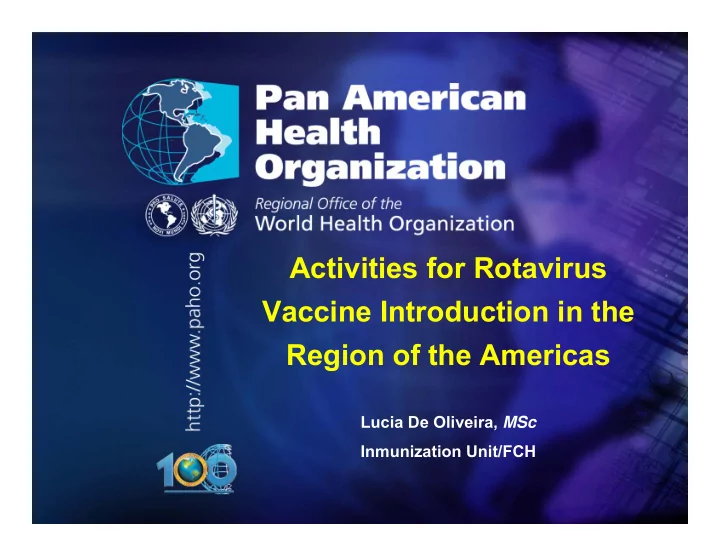

. Activities for Rotavirus Vaccine Introduction in the Region of the Americas Lucia De Oliveira, MSc Inmunization Unit/FCH
Topics • Implementation and results of rotavirus surveillance • Distribution of Rotavirus serotypes in the Region • Rotavirus vaccine introduction • Adverse Event Sentinel Surveillance Network • Activities: conducted and planed
Essential Components of RV Surveillance in the Americas • Standardized case definitions & investigation forms • Sentinel hospital sites – strategic selection and follow-up support • Standardized laboratory techniques
Essential Components of RV Surveillance in the Americas • Timely flow of information • Monitoring using standardized indicators & feedback strategies • Economic analysis studies: ProVac
Surveillance in the Americas • Standardized Surveillance of diarrheas in sentinel hospitals : • BOL, ELS, GUAT, HON, PAR,VEN, and English-speaking Caribbean countries (4 countries) • Protocols developed and being implemented in ARG, and PER • Nicaragua is developing a demonstration project for the introduction of the vaccine
Data from Sentinel Rotavirus Surveillance, selected countries, Region of Americas, 2005. Source: Country reports to PAHO
Surveillance Indicators, 2005 Source: country reports to PAHO Venezuela: total hospitalized diarrhea cases not reported Caribbean: included diarrhea cases in outpatients
Percentage positive rotavirus results, selected countries, American Region, Jan-Dec, 2005 . 100 90 80 70 60 50 40 30 20 10 0 Jan Feb Mar Apr May Jun Jul Aug Sep Oct Nov Dec Guatemala Honduras El Salvador Caribeean Bolivia Paraguay Bolivia Source: country reports to PAHO
DI STRI BUTI ON OF ROTAVI RUS TYPES I N LATI N AMERI CA FROM 1982 TO 2004 Type Brasil Argentina Paraguai México Chile Colombia Guatemala CAREC Nicaragua Total P-G 31 691 P[8]G1 261 136 10 184 65 3 1 -- 6 P[8]G3 32 1 -- 55 -- -- 1 95 -- P[8]G4 21 59 30 -- 4 -- -- 19 133 -- P[4]G2 85 246 1 66 20 1 -- -- -- 419 P[8]G2 23 2 -- 9 1 -- -- -- 35 -- P[8]G5 24 2 9 -- -- -- -- -- 35 -- P[8]G9 80 -- 12 -- -- 15 16 3 126 -- 34 34 P[8]G8 -- -- -- -- -- -- -- -- P[6]G1 18 8 -- -- -- -- -- -- 26 -- P[6]G2 4 -- -- -- -- 1 -- -- -- 5 P[6]G4 12 1 -- 4 -- -- -- -- 17 -- P[6]G8 -- -- -- -- -- -- 01 -- 1 -- P[6]G9 11 2 -- 2 -- 4 -- -- -- 19 P[4]G9 -- -- -- -- -- 1 -- -- -- 1 P[4]G3 18 -- -- 4 -- 5 -- -- -- 27 P[4]G1 16 35 1 14 2 3 -- -- -- 71 Not typed 203 119 37 62 29 49 16 21 23 559 Mix 103 67 23 60 2 5 -- -- -- 260 infections Laird et al. 2003; Castello et al ., 2004; Urbina et al ., 2004; Parra et al ., 2005; Mascarenhas et al ., 2006; Volotão et al . 2006; countries data , 2005-2006.
Genotypes of Rotavirus Circulating in Latin America 1996-2005 NT 23% P[8]G1 34% Unusual 6% P[8] G2, 5 P[6] G1,4,9 P[4] G3,1 P[8]G3 P[8] G8 P[6] G2, 4,12 5% P[4]G2 P[8]G4 22% 6% P[8]G9 4% Laird et al. 2003; Castello et al ., 2004; Urbina et al ., 2004; Parra et al ., 2005; Mascarenhas et al ., 2006; Volotão et al . 2006; countries data, 2005-2006.
Pro-Vac : Economic Analysis of New Vaccine Introduction Answering questions with Vaccine Burden of economic Distance Learning Introduction Disease analyses Costs Tool Tools Economics for Working with Decision Partners Making Costs Benefits Gathering data & performing analyses Tools for Regional Ongoing Support to Economic Workshop Countries Analysis
Countries Introducing Rotavirus Vaccine into their routine schedule Countries using Rotavirus Vaccine Venezuela: April Countries considering Pop < 1yr :590,000 introduction Panama: March Pop < 1 yr:70,000 Brazil: March Pop <1 yr: 3,711,000
Lessons learned for introduction of new vaccines: evaluation points � Sustainability of national EPI � Programmatic feasibility: √ vaccination schedules in routine programs; √ cold chain capability; √ human resources available; √ training and supervision at all levels; √ information system; √ strengthening adverse event reporting system
Sentinel Adverse Event Surveillance Network (SANEVA) Meeting in Brazil, March 2006 Participants included epidemiological surveillance and NRA from Argentina, Brazil, Mexico, Panamá , Venezuela, WHO and PAHO Objectives: • To start post-marketing surveillance for ESAVIs (adverse events following immunization) of new vaccines with rotavirus • To build an alert system for unexpected adverse events • To strengthen the existing systems • To facilitate the opportunity exchange information about adverse events • To monitor effectiveness of new vaccines in a medium term • To strengthen the coordination between EPI and NRA
ESAVIs related rotavirus vaccine reported by SANEVA Diarrhea Vomiting Fever Abdominal Distension Intestinal obstruction Intramuscular administration (programmatic error) Intussusception: � Brazil: 0.3 / 10,000 doses administered � Venezuela: 2 / 10,000 doses administered
Activities conducted (1/2) • International Workshop for Rotavirus Diarrhea Surveillance, Brazil (Dec 2005): surveillance and laboratory personal from all Latin American countries • Enhanced on-site technical cooperation (since Nov- Dec 2005): Consultants working in Bolivia, El Salvador, Honduras, Nicaragua, and Guatemala.
Activities conducted (2/2) • Training for laboratory personnel (Nov-Dec 2005): for Guatemala and Venezuela in Evandro Chagas/Brazil, and for Bolivia and Peru in FIOCRUZ/Brazil • Training on rotavirus vaccine adverse events for staff in sentinel sites ( Brazil, Mar 2006) • Field guide “Rotavirus Diarrhea Surveillance in Sentinel Hospitals” (Publication expected in Jul 2006)
Planned Activities ● Accelerate development of rotavirus surveillance projects in all PAHO countries ( 2004-2006) ● International workshop on economic studies-ProVac followed by country- led cost-effectiveness studies (September 2006) ● Workshop on virus concentration in rotavirus vaccines- PAHO/WHO ARG, BRA, CHI, COL, CUB, ECU, MEX, PER, and VEN ( Jun 2006) ● To publish Vaccine Introduction Guidelines based on WHO Guidelines (Sep 2006) ● Laboratory network coordination meeting and training (Feb 2007) ● Regional surveillance meeting (2007)
Muito obrigada! Thank you!
Recommend
More recommend